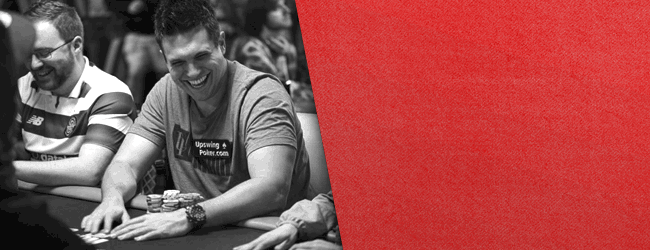You Probably Aren’t Loose Aggressive Enough in These 4 Common Poker Spots
The overwhelming majority of poker players are not aggressive enough.
If you want to compete with high level players, or if you just want to maximize your win-rate against weak ones, you’ll need to ditch the A-B-C approach and add some well-timed aggression to your poker game.
Specifically, you need to do two things:
- Identify spots that you rarely or never bluff, then consider working bluffs into that range.
- Constantly look to create new ranges by considering betting or raising in situations that you would typically never bet or raise.
But finding good spots to be more aggressive is no easy task, and the last thing we want you to do is over-bluff your stack away during your next session.
So, we’re going to get you started on the right track by breaking down 4 specific spots that almost everyone plays too passively. These spots include:
- Probing on the turn
- Raising against a turn continuation bet
- Delayed c-betting
- Check-raising on the flop after calling a 3-bet
We’ll round out the article by taking a look at a spot that you should never play aggressively.
Let’s get started!
Probing on the turn
A probe bet is when you bet out of position into a player who had an opportunity to continuation bet on the prior street, but didn’t. Probing is only possible on the turn or river.
In general, you can profitably bluff-probe often because most poker players have a weak check-back range on the flop. In light of this, it’s fine to create a probe range that is weighted a bit more towards bluffs, especially against weaker opponents who don’t concern themselves with balance.
That said, you shouldn’t go absolutely bananas and probe every time you have air. This is for two reasons:
- You open yourself up to being exploited by more experienced players who pick up on your strategy.
- You’ll end up over-bluffing on board textures that are favorable for your opponent’s range.
It’s therefore important to tailor your probe range to fit the board texture. If the board is advantageous for your range–think 8-6-5-3 or T-9-5-4–you can probe at a high frequency to force folds from your opponent’s many weak and unimproved hands. On disadvantageous boards–like J-9-4-A or A-K-6-6–you should do a lot more checking to avoid over-bluffing into a range that contains many strong hands.
One last word of advice on probing: because most players have a weak check-back range, you can also probe quite thinly for value without much concern of running into a stronger hand.
(Note: If you think our free content is good, the material in the Upswing Lab is next level. Master expert strategies from our world-class team of coaches and join our members only community. Learn more now!)
Raising versus turn c-bets after calling the flop
After calling a flop bet, you shouldn’t raise innocuous turns very often. Most of the value hands we have on the turn will have been value hands on the flop, so we’ll have wanted to raise them for value then.
There are a few instances, however, when this is not the case. Let’s look at an example:
100NL 6-max on PokerStars. 100BB effective stacks.
Hero is dealt 5♥ 5♦ on the button
utg folds. Hijack raises to $2.50. co folds. Hero calls. blinds fold.
Flop ($6.50) J♠ 8♣ 2♦
Hijack c-bets $2.75. Hero calls.
This flop call is on the loose side, but it can’t be too bad considering you are in position and getting better than 3 to 1 odds on a call. Let’s take a turn.
Turn ($12) 5♠
Hijack c-bets $7. Hero…
Favorable card.
You now have a set, and want to raise it for value, but you also need to pick some bluff-raises to balance this out. Since pocket fives–of which you have 3 combos–makes up your entire value range in the spot (unless you’d slow-play 88 and 22 on the flop), you only need 2 or 3 bluff combos to stay balanced.
The best bluffing hands in terms of equity are Q♠ T♠ or T♠ 9♠, although these hands might play better as calls to avoid the possibility of facing a 3-bet shove. T9s (without a flush draw) is another great bluffing hand with solid equity. The specific hands you choose to bluff with don’t matter that much, so long as your value-bluff ratio remains close to being balanced.
You can apply this same methodology in pots where the flop went check-check. Just make sure you consider which hands you would have bet with on the flop so that you don’t try to represent them when raising the turn.
Delayed c-betting
A delayed c-bet is when the preflop aggressor bets the turn after the action checked through on the flop.
You’ll usually want to delay c-bet for value when your hand is not strong enough to bet for value across three streets (some might call this “pot control” but that is an oversimplification). A common example is when you’ve raised with a low suited ace and check back after the flop comes ace-high. You’ll also want to delay c-bet for value when you flop a very strong hand that blocks many of your opponent’s strong hands, like QQ on Q-7-2.
Choosing bluff delay c-bets is a lot trickier than choosing value bets, especially for players who c-bet with any draw on the flop, leaving them with no obvious bluffing hands on the turn.
A good strategy is to sometimes check back your backdoor draws with the intention of bluffing a turned draw. For example, you could check back K♦ 5♦ on a flop of J♠ 7♣ 6♦ with the intention of bluffing any turn that gives you a draw (9, 8, 4, 3 or a diamond). Admittedly, it will suck if the turn is a brick and you are forced to fold to a probe, but this is just one of the realities of playing solid and balanced poker.
Here’s a couple rules of thumb that will help you decide which of your backdoor draws to c-bet on the flop, and which to delay c-bet:
- Lean towards c-betting with lower backdoor draws that will struggle against probes, like 6♠ 5♠ on A♠ K♥ 3♦
- Lean towards delay c-betting with higher hands that will be able to call some probes, like the K♦ 5♦ example above.
There will also be spots where you check back the flop, don’t turn any equity, and then have a chance to take a stab at the pot after being checked to. To my mind, picking hands in this situation can feel somewhat arbitrary, but don’t let that stop you. You can at least consider what hands you block if you don’t have any equity, and proceed from there.
(Note: When it comes to studying poker, it can be tough to know where to begin. You can study the game with step by step instructions and examples for a huge number of topics when you join the Upswing Lab. Learn more now!)

Check-raising on the flop after calling a 3-bet
Sometimes you’ll call a 3-bet out of position and flop a monster hand that might stack an opponent with an overpair or top pair. Here, when you face a c-bet, you have two options:
- Check-raise versus the c-bet and shove the turn.
- Call down so that we get value from our opponent’s value hands and bluffs.
If you go with the first option, then you need to think about hands to bluff check-raise. Let’s look at an example:
$0.50/$1.00 6-max on PokerStars. $100 effective stacks.
Hero is dealt T♣ T♦ in the hijack
utg folds. Hero raises to $2.50. Cutoff 3-bets to $8. 3 folds. Hero calls.
Flop ($17.50) J♦ T♠ 4♠
Hero checks. Cutoff bets $10. Hero raises to $32.
Your value hands here are TT, JJ and JTs, so we need to pick a some bluffs to balance these out. The most obvious candidates are the combo draws–A♠ Q♠ and K♠ Q♠, plus A♠ K♠ and 9♠ 8♠ if we call those preflop–which have a lot of equity.
However, these combo draws have too much equity to really be considered as bluffs. If these are your only “bluff” hands, then your range will be far too strong and your opponent can exploitatively fold to the check-raise. So, we need a some hands with less equity.
Potential candidates include non-spade combos of KQs, and combos of AKo and AQo that include a single spade. We could balance out our turn jamming range by check-folding some of our AKo and AQo combos if the turn is not a spade, and jamming everything else.
Don’t donk-lead on the flop
The point of this article is to encourage players to bluff more. However, there are spots where you should never have a betting range. In particular, when you are heads-up and out of position against the preflop aggressor on the flop. (If you watch Doug Polk’s Poker Hands videos, you’ve already heard this a hundred times.)
This is because your opponent’s range will usually be stronger than yours, which means your value bets need to be very strong in order to beat his. It makes more sense to play these value hands as check-raises rather than leads for three reasons:
- Your opponent will usually value bet with strong hands, which allows you to bloat the pot size with a check-raise.
- You will induce a bet from some of your opponent’s c-bet bluffs.
- It protects your checking range.
It’s a very common mistake for new players to lead on the flop with vulnerable hands, such as a low top pair on a board like 8-6-5. This is generally a bad move, as you’ll end up forcing folds from most of the hands that you beat (which has the upside of denying equity), and get called by all the hands that beat you. In other words, they usually function as very inefficient bets.
In any particular spot, if it doesn’t make sense to have any value bets, then it doesn’t make sense to have any bluffs. While it may seem smart to stab at a flop that has likely missed your opponent, competent opponents will realize that you don’t have any value hands and exploit you by floating and/or raising.
Want to delve deeper into donk-betting? Check out Should You Ever Donk-Bet On the Flop?
Conclusion
There is a lot to digest in this article. If you feel overwhelmed, don’t worry: no one gets the hang of aggressive play overnight.
Re-read this article if needed, and check out Upswing’s library of content for more examples of range building in spots like these.
Good luck!
Note: Want to turn your poker hobby into a profitable side job? Put a beat down on your opponents with the expert strategies you’ll learn in the Upswing Lab. Find out more!

Read more from Upswing Poker: